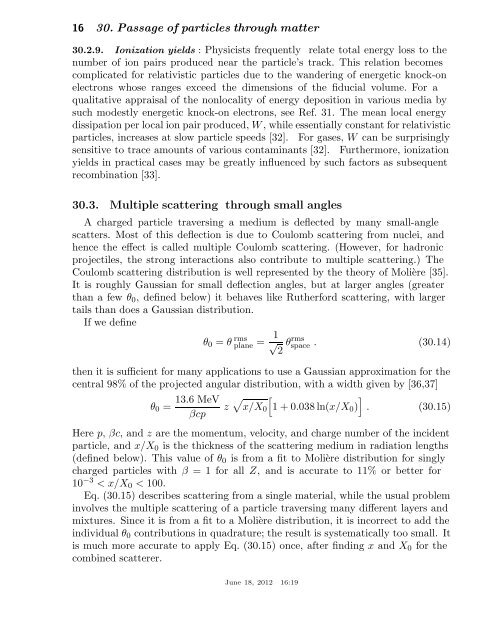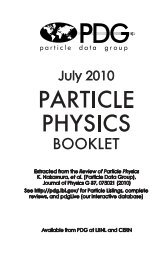30. Passage of particles through matter 1 - Particle Data Group
30. Passage of particles through matter 1 - Particle Data Group
30. Passage of particles through matter 1 - Particle Data Group
Create successful ePaper yourself
Turn your PDF publications into a flip-book with our unique Google optimized e-Paper software.
16 <strong>30.</strong> <strong>Passage</strong> <strong>of</strong> <strong>particles</strong> <strong>through</strong> <strong>matter</strong><br />
<strong>30.</strong>2.9. Ionization yields : Physicists frequently relate total energy loss to the<br />
number <strong>of</strong> ion pairs produced near the particle’s track. This relation becomes<br />
complicated for relativistic <strong>particles</strong> due to the wandering <strong>of</strong> energetic knock-on<br />
electrons whose ranges exceed the dimensions <strong>of</strong> the fiducial volume. For a<br />
qualitative appraisal <strong>of</strong> the nonlocality <strong>of</strong> energy deposition in various media by<br />
such modestly energetic knock-on electrons, see Ref. 31. The mean local energy<br />
dissipation per local ion pair produced, W, while essentially constant for relativistic<br />
<strong>particles</strong>, increases at slow particle speeds [32]. For gases, W can be surprisingly<br />
sensitive to trace amounts <strong>of</strong> various contaminants [32]. Furthermore, ionization<br />
yields in practical cases may be greatly influenced by such factors as subsequent<br />
recombination [33].<br />
<strong>30.</strong>3. Multiple scattering <strong>through</strong> small angles<br />
A charged particle traversing a medium is deflected by many small-angle<br />
scatters. Most <strong>of</strong> this deflection is due to Coulomb scattering from nuclei, and<br />
hence the effect is called multiple Coulomb scattering. (However, for hadronic<br />
projectiles, the strong interactions also contribute to multiple scattering.) The<br />
Coulomb scattering distribution is well represented by the theory <strong>of</strong> Molière [35].<br />
It is roughly Gaussian for small deflection angles, but at larger angles (greater<br />
than a few θ0, defined below) it behaves like Rutherford scattering, with larger<br />
tails than does a Gaussian distribution.<br />
If we define<br />
θ0 = θ rms<br />
plane = 1 √ 2 θ rms<br />
space . (<strong>30.</strong>14)<br />
then it is sufficient for many applications to use a Gaussian approximation for the<br />
central 98% <strong>of</strong> the projected angular distribution, with a width given by [36,37]<br />
13.6 MeV<br />
θ0 = z<br />
βcp<br />
� �<br />
�<br />
x/X0 1 + 0.038 ln(x/X0) . (<strong>30.</strong>15)<br />
Here p, βc, and z are the momentum, velocity, and charge number <strong>of</strong> the incident<br />
particle, and x/X0 is the thickness <strong>of</strong> the scattering medium in radiation lengths<br />
(defined below). This value <strong>of</strong> θ0 is from a fit to Molière distribution for singly<br />
charged <strong>particles</strong> with β = 1 for all Z, and is accurate to 11% or better for<br />
10 −3 < x/X0 < 100.<br />
Eq. (<strong>30.</strong>15) describes scattering from a single material, while the usual problem<br />
involves the multiple scattering <strong>of</strong> a particle traversing many different layers and<br />
mixtures. Since it is from a fit to a Molière distribution, it is incorrect to add the<br />
individual θ0 contributions in quadrature; the result is systematically too small. It<br />
is much more accurate to apply Eq. (<strong>30.</strong>15) once, after finding x and X0 for the<br />
combined scatterer.<br />
June 18, 2012 16:19







